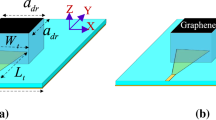Abstract
This article presents a new methodology allowing to design a planar electromagnetic band-pap antenna (choice of theebg material, sizing, feeding). This kind of antenna has already been presented.ebg antennas are very thin (compared with parabolic reflectors) high gain antennas. This article makes easier the realization ofebg antennas whatever the operating frequency, the gain, or still the bandwidth. A study about the sensitivity of the material properties on the performances is also presented. Finaly two exemples using this design method are described.
Résumé
Cet article décrit une méthodologie complète inédite permettant de dimensionner et de réaliser une antenne planaire à bande interdite électromagnétique (Choix du matériau, de la configuration, dimensionnement, alimentation...). Le fonctionnement de ce type d’antenne a déjà été publié. Les antennesbie sont des antennes directives à encombrement réduit en épaisseur (En comparaison avec par exemple une antenne parabolique). Cet article facilite la réalisation des antennesbie quelques soient la fréquence, le gain ou encore la bande de fonctionnement. Une partie concerne également la sensibilité des éléments du matériau sur les performances de l’antenne. Enfin, deux exemples concrets utilisant cette méthode de conception sont présentés.
Similar content being viewed by others
References
Thevenot (M.),cheype (C.),Reinex (A.),Jecko (B.), “Directive photonic bandgap antennas”,ieeeTransactions on microwave theory and techniques,47, no 11, November 1999, pp. 2115–2122.
Yablonovitch (E.), “Inhibited spontaneous emission in solid state physics and electronics”,Phys. Rev. Lett.,58, 1987, pp. 2059–2062.
Gonzalo (R.),Martinez (B.),De Maagt (P.),Sorolla (M.), “Improved patch antenna performance by using photonic bandgap substrates”,Microwave Opt. Technol. Lett.,24, 2000, pp. 213–215.
Gonzalo (R.),De Maagt (P.),Sorolla (M.), “Enhanced patch antenna performance by suppressing surface waves using photonic bandgap substrates”,ieeeTrans Microwave Theory Tech,44, 1999, pp. 2131–2138.
Colburn (J.S.),Rahmat-Amii (Y.), “Printed antenna pattern improvement through substrate perforation of high dielectric constant material: Anfdtd evaluation”,Microwave Opt Technol. Lett.18, 1998, pp. 27–32.
Horii (Y.),Tsutsumi (M.), “Harmonic control by photonic bandgap on microstrip patch antenna”,ieeeMicrowave and guided wave letters,9, no 1, January 1999, pp. 13–15.
Poilasne (G.),Pouliguen (P.),Mahdjoubi (K.),terret (C.),Gelin (P.),Desclos (L.), “Experimental radiation pattern of dipole inside metallic photonic bandgap material”,Microwave and Opt. Technol. Lett.,22, no 1, July 1999, pp. 10–16.
Poilasne (G.),Pouliguen (P.),Mahdjoubi (K.),Desclos (L.),terret (C.), “Active metallic photonic band gap materials (mebg): experimental results on beam shaper”,ieeeTransactions on antennas and propagation,48, no 1, January 2000, pp. 117–119.
Kesler (M.P.),Maloney (J.G.),Shirley (B.L.), “Antenna design with the use of photonic band-gap materials as all dielectric planar reflectors”,Microwave and Opt. Technol. Lett.,11, no 4 March 1996, pp. 169–174.
Smith (G.S.),Kesler (M.P.),Maloney (J.G.), “Dipole antennas used with all-dielectric, woodpile photonic-bandgap reflectors: Gain, field patterns, and input impedance”,Microwave and optical Technol. Lett.,21, no 3 May 1999, pp. 191–196.
Thevenot (M.),Reinex (A),Jecko (B.), “A dielectric photonic parabolic reflector”,Microwave and optical Technol. Lett.,21, no6 June 1999, pp. 411–414.
Biswas (R.),Ozbay (E.),temelkuran (B.),Bayindir (M.),Sigalas (M.M.),Ho (K.M.), “Exceptionally directional sources with photonic-bandgap crystals”,J. Opt. Soc. Am B,18, no 11, November 2001, pp. 1684–1689.
Serier (C.),cheype (C.),Chantalat (R.),Thevenot (M),Monediere (T.),Reinex (A.),Jecko (B.), “ID photonic bandgap resonator antenna”,Microwave and optical Technol. Lett.29, no 5 June 2001, pp. 312–315.
Qiu (M.),He (S.), “High directivity patch antenna with both photonic bandgap substrate and photonic bangap cover”,Microwave and optical Technol. Lett.,30, no 1 July 2001, pp. 41–44.
Author information
Authors and Affiliations
Rights and permissions
About this article
Cite this article
Leger, L., Serier, C., Chantalat, R. et al. 1D dielectric electromagnetic band gap (EBG) resonator antenna design. Ann. Télécommun. 59, 242–260 (2004). https://doi.org/10.1007/BF03179697
Received:
Accepted:
Issue Date:
DOI: https://doi.org/10.1007/BF03179697
Key words
- Dielectric antenna
- Periodic structure
- Unidimensional medium
- Flat plate
- Parallel plate
- Forbidden band
- Artificial dielectric
- Dielectric resonator
- Quality factor
- Directivity
- Bandwidth
- Antenna synthesis




